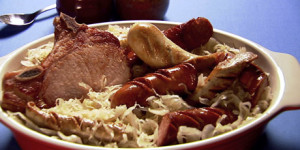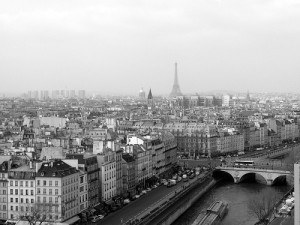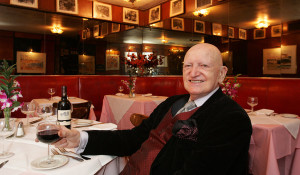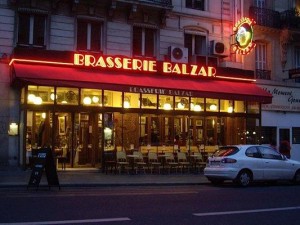All of HG/BSK’s French dining has been done in Paris during numerous visits beginning in 1967. Still love eating there though prices keep moving upwards, good brasseries have virtually disappeared and homey bistros are becoming a rarity. After spending a week dining in Reims and its immediate vicinity, HG has come to a number of conclusions, some surprising. The oysters at Boulingrin (two visits) and Le Bocal (one visit) are better than any oysters HG has ever slurped (BSK agrees). Proximity to Normandy and other oyster regions? Le Bocal is better (and much cheaper) than any seafood restaurant in Paris. Anna-S is as good as most of the new cutting edge bistros in Paris (most helmed by young Japanese chefs). Some Reims dishes are outshone by their Paris counterparts. Rare roast duck breast at Le Madelon is far inferior to the version served by Chez Georges in Paris. Boulingrin’s skate with capers doesn’t compare to the version served by Rech in Paris. Oddly, cheese in Reims is not great. In one restaurant HG had to send back a round of St. Marcellin. Ice cold and as hard as a hockey puck. A camembert bought at a cheese shop disappointed. The bread and rolls served in Reims restaurants are very good, better than Paris. HG has never had a great choucroute in Paris. The choucroute (a huge, lavish affair HG spied at a neighboring table at Boulingrin) looked like a class act. Will have it if good fortune brings HG back to Reims. If you did not have enough reasons already to want to visit Reims, then here is another: champagne. Reims is in the heart of champagne country and cafes and restaurants offer a staggering array of bubbly ambrosia, many from small local vineyards which one will never see in the US. Lots of splendid bottles priced at 30 Euros. HG/BSK drank some very good champagne for 7 Euros a glass (a very generous pour) in a charming cafe. A pleasant cocktail hour.
Reims VS Paris
December 4th, 2015 § 0 comments § permalink
Reims Dining: Brasserie du Boulingrin
November 30th, 2015 § 0 comments § permalink
Paris brasseries have entered a sad period. Once delightful places like La Coupole, Vaudeville, Bofinger, Balzar, Flo have been purchased by giant restaurant chain-conglomerates and now roll out industrialized food. Glittering decor and fresh oysters can still be relied upon. But, that’s it. The old time hip, lively and happy atmosphere has disappeared. Only Le Stella in the 16th keeps the old traditions. Its carte is a virtual parade of traditional dishes: Tete de veau; steak tartare; sole meuniere; choucroute; Iceland herring; steak frites; ile flottante, etc. The affluent residents of the 16th have impeccable manners but restraint is cast off when they confront Stella’s vast plateau de fruits de mer. In Reims, the Brasserie du Boulingrin maintains the old brasserie spirit. Art deco interior. Smoked glass and mirrors. Red leatherette banquettes. Young, smiling waitpersons. Dinner conversations are animated but the noise level is kept at a civilized pitch (This seems characteristic of French restaurants in contrast to their noisy American counterparts). On a second visit, HG sipped a cold, dry Muscadet, while devouring a dozen big, briny oysters. This was followed by very generous servings of sole meuniere. Two large fish were deboned deftly by the young woman serving HG/BSk. The filets were gilded by spoonfuls of buttery lemon cooking juices. Served with bowls of buttered boiled potatoes dusted with parsley. Dessert was, in keeping with Boulingrin’s generosity, dinner plate-sized creme brûlées. HG sipped an after dinner glass of cold Mirabelle and reflected upon the good fortune of having a splendid wife, a loving family and an appetite geared to the delights of old fashioned brasserie dining. HG interrupted this happy contemplation with a bout of severe envy as he watched a choucroute garnie presented to a young man at an adjoining table. The platter of kraut, sausages and pork was kept warm under a glass dome. This single portion seemed large enough to feed a platoon of Prussian Hussars. HG vowed to sample it if HG ever makes it back to Reims and Boulingrin.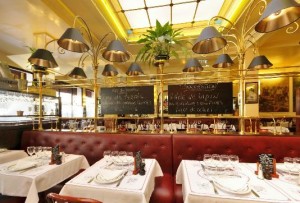
French Restaurants
November 15th, 2015 § 2 comments § permalink
The following post was written before the Paris terrorist attacks. As HG has noted in HG’s comments about Paris and the recent horrors (“PARIS”), HG/BSK will never abandon France and Paris. To do so would hand victory to terrorists.
The great writer, AJ. Liebling (his war journalism, restaurant and Paris recollections, press criticism, accounts of boxing matches, portraits of raffish characters are incomparable examples of wit, insight and erudition), once compared the attitude of a gourmand to his (or her) next meal to that of a lover contemplating an assignation. First, there is anticipation. Then, there is consummation. And, then there is sweet memory. HG is now in the anticipation stage as HG contemplates dining in the lovely French city of Reims where HG/BSK will be spending Thanksgiving week. HG/BSK; daughter Lesley R.; son-in-law Massimo R. and granddaughter Arianna R. have booked a three bedroom apartment there (plus a spacious auto). Granddaughter Sofia R. is in her first year of international studies at the university in Reims so this will be a jolly family reunion and an occasion for festive feasting. The proliferation of restaurant websites has made meal anticipation easeful and rewarding. HG has been studying the menus of the restaurants Massimo has selected for the visit (he has been in Reims before so he is well informed). Happily, prices are lower than Paris and the array of champagnes is extraordinary (Reims is in the heart of champagne country). Restaurants offer a splendid array of oysters (HG will accompany them with flutes of bubbly). Happily, the restaurants Massimo has selected offer a plethora of the old fashioned French dishes that HG adores: Charolais steak tartare; sole meuniere; tete de veau; ham and parsley terrine; escargots; rare rib steak with pommes frites; profiteroles; baba au rhum; creme brûlée, etc. On the websites, HG has encountered dishes he never had in French bistros and brasseries. A casserole of monkfish with mushrooms, for example. So, there will be a bit of adventurous dining. And, happily, HG will be back in French restaurants with their professional service, flattering lighting and unique ambience. Be assured, gracious readers, HG will be posting full accounts.
Choucroute Garnie
October 28th, 2015 § 2 comments § permalink
Choucroute simply means sauerkraut. Choucroute Garnie (on French brasserie and bistro menus) is sauerkraut cooked with a variety of pork products. Chez Jenny in Paris has always been touted as a great place for Choucroute. HG disagrees. The Paris best is Brasserie de I’Isle St. Louis. Despite a touristy location near Notre Dame, the brasserie turns out serious, old fashioned French food. Dedicated foodies say that to taste real choucroute one must travel to Alsace. HG is not that dedicated and likes BSK’s home cooked choucroute. BSK rinses a jar of Bubbie’s sauerkraut and cooks it with onions, juniper berries and white wine (SJ notes that a nice Riesling is the preferable choice). Adds Kassler Rippchen (German smoked pork chops from Schaller & Weber online) and knockwurst. Serves it with boiled potatoes, French cornichons and Keen’s English Mustard. Noted food writer Jeffrey Steingarten attempted to codify the ingredients of Choucroute in his wonderful book The Man Who Ate Everything, but one of the joys of making the dish at home is going to a good German/Polish/Alsace butcher (SJ reccomends Jubilat Provisions for Brooklyn folk) and picking out numerous yummy things. Cold beer or ale with a shot or two of chilled vodka are the obligatory beverages.
First Trip To Europe: Paris
September 15th, 2015 § 2 comments § permalink
1966. Spring. HG/BSK were accompanied by precocious, articulate, two-year-old daughter, Lesley. The exchange rate was very favorable. The family stayed at the charming Left Bank hotel, Pont Royal, on the Rue du Bac. HG/BSK were beguiled by the tiny elevator with its brass ornamentation (could baely fit a suitcase onto it). Had a pleasant, cozy suite with a separate little bed for Lesley (who would have sneered at a childish crib). The hotel atmosphere was shabby bohemian (HG/BSK’s dream of Paris). HG/BSK didn’t know that the downstairs bar was a literary hangout where Sartre, Simone De Beauvoir, Truman Capote, Arthur Koestler and others held forth over carafes of cheap wine. HG/BSK and Lesley walked along the Seine, visited museums, shopped in boutiques. BSK scored a short leather jacket and print dress and soon fit in very nicely with the very pretty Parisiennes. Lesley was much admired at the cafes for her enchanting, curly topped cuteness. Devoured Croque Monsieurs with a hearty appetite. HG/BSK left Lesley with an American student babysitter when they had their first great Paris meal. It was at a long gone bistro on the Boulevard St. Germain. HG/BSK shared an appetizer of smoked salmon and a half bottle of chilled Chablis. Delectable. And, then came a dish of a lifetime, never to be duplicated. The waiter brought fat, white spring asparagus wrapped in a linen cloth. There was a bowl of Sauce Mousseline (Hollandaise mixed with whipped cream). Lush food. Main was a bistro classic: Gigot (leg of springtime lamb) cooked rare and accompanied by flageolets. Drank Moulin a Vent (delicious Beaujolais slightly chilled). Perfection. Dessert was wild strawberries served with a pitcher of sweet cream. A spring dream. The meal was a harbinger of the great feasting HG/BSK enjoyed at cozy Paris bistros and lively brasseries for the next 49 years. HG’s appetite for Paris has never diminished.
Hospitality and Generosity
May 16th, 2015 § 4 comments § permalink
Restaurant cooking is probably better than ever. Chefs are more creative and less provincial. They are willing to stretch themselves, using the spices, foods and flavors of numerous countries in their cooking. And, many chefs are seeing outside the confines of their kitchen and addressing global problems of climate change and health by sourcing sustainable (and local) produce, meat and fish. However, because of rising costs and (specially in New York) the crushing burden of rent, most restaurants lack the two important qualities that make dining out memorable: Generosity and Hospitality. These qualities always impressed HG/BSK when dining in Italy. So many happy memories of modest trattorias and osterias where HG/BSK were treated like family members rather than tourists with a very modest amount of Italian language skills. Chefs would often send a few additional gratis tastes to HG/BSK’s table. HG has a happy memory of the proprietor of a seaside restaurant walking through the room with a big bowl of seafood risotto insisting the customers have a taste. Paris bistros and brasseries (for the most part) have lost their welcoming spirit. Today, after being assured HG/BSK’s reservations are in order, the maitre d’ seats them in a ghetto reserved for non-Francophones—mainly Japanese and Chinese tourist plus boisterous Germans and Russians. This is in sharp contrast to the welcomes of yesteryear. HG recalls a lunch some 30 years ago at Chez Georges, then as now, an excellent bistro serving classic French food. Cold November day and HG/BSK arrived without a reservation. No matter, said the smiling bistro owner, the wait will be short. Made them comfortable standing at the bar. Poured two glasses of fine Brouilly and provided some dry sausage to nibble. Seated in about seven minutes, HG/BSK relished their salads of frisee with lardons and poached eggs. Ate other good things –rare duck breast, sole meuniere, pommes frites., etc. That old time French bistro spirit was always alive and well at the delightful Veau d’ Or on E. 60th Street in New York. When you were seated, the proprietor immediately provided you with an appetite sharpening saucer of mussels in a savory mustard sauce. Waiters enjoyed HG’s exuberant pleasure in Veau d’ Or’s lusty cuisine. When HG knocked off some delicious quenelles in record time, the waiter replenished the plate. Smiled, No charge. A happy time.(The photo is of the late Robert Treboux, the genial owner of Le Veau d”or. He said of his traditional restaurant: “Those seeking trends should go elsewhere.”)
Sweet Finish
October 20th, 2014 § 0 comments § permalink
At some good Paris restaurants and bistros there’s a nice beau geste at the end of a meal: A little tray of bon bons and chocolates served with coffee or a liqueur. James Salter, that excellent writer who constructs sentences as exquisitely balanced as a crystal glass of Chateau Margaux, notes in his book “Life Is Meals” that he and his wife often serve sweets at the end of a dinner party. The discerning Salters favor Enstrom’s Butter Crunch (manufactured in Grand Junction, CO.). They state unequivocally (and HG agrees) that this is the best candy in the world. When HG/BSK are out of this delectable they serve dark chocolate and Belgian Butter Cookies. Excellent peanut brittle also delights guests. The nutty goody was discovered at the Latino-centric Pojoauque Super Market, a short drive from the HG/BSK New Mexico home.
Bittman Attacks French Food
July 26th, 2014 § 0 comments § permalink
Mark Bittman, the seemingly omnipresent food writer, did a recent op-ed piece in The New York Times bewailing the state of restaurants in France and their reliance on food “cooked at a faraway factory.” He is quite harsh in his opinions concerning Paris restaurants (he has to research and eat at three in order to find one good one). Bittman exaggerates (slightly). Sure, there are bad restaurants in France (as in every country) where owners pay more attention to profit than dining pleasure. And, sure, Paris is no longer the dining capital of the world. New York has taken over that spot. In addition to world class dining experiences like Per Se, Bernardin, etc., mighty Noo Yawk has an almost limitless array of interesting ethnic restaurants ranging from the entire spectrum of Korean and Chinese restaurants in Flushing to Ghana taxi driver food on the Grand Concourse in The Bronx to Uzbekistan eateries in Rego Park. And, if you want to recapture the golden age of French cuisine replete with lush flowers, deft service and classic dishes, one can turn back the clock and empty one’s wallet at La Grenouille on Manhattan’s posh upper East side. And, then there’s Brooklyn with its astounding metamorphosis into the world’s center of hipness with a multitude of food experiences to match its style. But, Paris, though no longer the ultimate gourmand destination, still has much to offer. Super baguettes and Poilane bread. Very good oysters (and guys who know how to shuck them). The best cheese and butter (Bordier). Wine shops stocked with splendid affordable vintages. Cafes, for the most part, offer mediocre food but world class viewing of stylish women (of all ages, thankfully). Bittman has a point. It’s not easy to find restaurants where fresh food is prepared on the premises. HG’s advice: Consult Alec Lobrano’s Hungry for Paris guide and John Talbott’s website. In Paris, HG spends much time at museums and cinemas. When it comes to food, HG is downscale. Favorite hangout is the back room of La Cave des Abbesses, a Montmartre neighborhood wine shop. In this very bare bones place, HG likes to linger over a platter of cheese with a carafe of red wine. In season, there are oysters for one Euro a piece. HG manages to get down a dozen with ease. La Cave is a nice place to visit after listening to the street musicians (usually quite talented) on the Place des Abbesses. HG also likes the gritty Arab/African neighborhood of Montmartre for couscous and other Maghreb specialties. Jour et Nuit is a good place for a hearty meal with the locals. Big flavors. Tiny prices.
Balzar & Gopnik
May 13th, 2014 § 0 comments § permalink
Brasserie Balzar on the Rue des Ecoles in Paris was (before its takeover by the Flo Group) HG/BSK’s favorite dining spot. Just a sprinkling of tourists. It had a true Parisian ambience. It was patronized by Left Bank publishers, writers, arts and antiques dealers plus many academics from the nearby Sorbonne. Many pretty women. Chic without pretension. The decor and lighting were slightly deco and infinitely comfortable. The waiters were wonderful. True professionals. No servility and no arrogance, collaborators with the diners in creating a delicious experience. The food? Classic, plain spoken French. Roast chicken. Broiled liver. Oysters. Mussels. Skate wing in black butter with capers (HG’s favorite). Choucroute garnie. Tarte tatin with gobs of creme fraiche. Sadly, Balzar is now just a shadow of itself, another soulless Flo brasserie like Coupole, Vaudeville, etc. You can read about efforts to save the old Balzar in Adam Gopnik’s book, Paris to the Moon. In HG’s opinion, this is the best book ever written about Paris and contains many brilliant perceptions about French culture, food, manners, etc. Gopnik has also written a very rewarding book about New York, Through the Children’s Gate–A Home in New York. It’s a wry and knowing view of New York (plus many insights into the rewards and trials of parenting). There’s also a comic masterpiece in the book, a chapter titled, Man Goes To See A Doctor. Its portrait of Gopnik’s psychoanalyst is indelible. Gopnik is a fount of wit and erudition. But, he’s not perfect. Born in Montreal, Gopnik prefers that city’s sweet, honey flavored (feh!!) bagels to New York’s robust bagels, the traditional companions of cream cheese and Nova.
Secret of A Good Paris Steak: Imported Meat
March 25th, 2014 § 0 comments § permalink
When HG wanted to get some vigorous jaw exercise in Paris, HG ordered a bavette (flank steak) or an onglet (hangar or butcher steak). Tough? These were broiled baseball mitts. Well, it seems times are changing and the outlook is rosy (or bleu or saignant) for the Paris steak eater. The French, supremely nationalistic about their cuisine, are finally making an admission: French beef can be admirable when long cooked as pot au feu or boeuf bourgignon. But, served as steak French beef is usually tough and tasteless when compared to imports from Germany, Scotland, Argentina and the United States. That’s why more than 20% of meat presently served in French restaurants is imported. And, that number is rising. Good Paris steakhouses like Le Severo and Au Boeuf Couronne now depend on imports. You can get a nice steak at those places (Severo’s frites are exemplary and Boeuf Couronne serves hard-to-find pommes souflee). But, if you want really great steak nothing beats a traditional New York eatery like Spark’s and Keen’s Chop House (yes, Peter Luger’s is good but a tad overrated). HG believes New York’s restaurateurs reserve the best cuts in the world for themselves.


